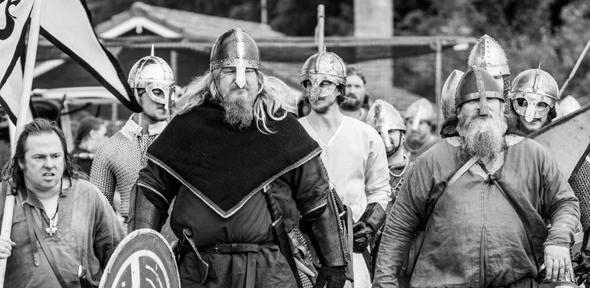
The medieval world has a powerful hold over our modern imaginations. We continually revisit this murky period of history in fictional frolics such as Game of Thrones, and stirring series including The Last Kingdom. Echoes of the so-called “dark ages” even carry as far as today’s politics – particularly when it comes to discussions about devolution.
Indeed, as Westminster begins to relinquish political powers to England’s newly-formed city regions, some have claimed that these territories should be defined by historical precedent, rather than administrative practicalities.
But how close are we to our medieval roots, and are our connections with the past really strong enough to influence modern-day decisions? To find out, we need to take a closer look at what’s left of the Celtic, Anglo-Saxon and Viking kingdoms of yore.
Ancient Elmet

Perhaps the most obvious links between past and present can be found simply by looking at the names of places on a map. Take, for example, the Leeds city region – one of the first regions to be granted new powers over transport and skills development.
This region encompasses the villages, towns and cities between Harrogate in the north, Barnsley in the south, Bradford in the west and York in the east, with Leeds at its heart. But it’s not the first time Leeds has been the centre of a regional power base; it was also at the core of the early medieval kingdom of Elmet.

This shadowy kingdom was under the control of Celtic rulers, who spoke a language akin to Welsh. It was later conquered by Edwin, an Anglo-Saxon king, in the 7th century and became part of his empire. Today, the kingdom is recalled in place names, and the parliamentary constituency of Elmet and Rothwell.
Yet despite these geographical similarities, this connection is tenuous – the modern Leeds city region also encompasses parts of North Yorkshire that would not have been in Elmet. And it’s unlikely that administrators had the medieval kingdom in mind when they were drawing the boundaries.
Pursuing the past
To find a more convincing connection between modern politics and medieval monarchs, we need to go beyond mere borders and explore cultural, political and genetic links. For instance, the advocates of Yorkshire devolution trace their heritage back to medieval times – and even earlier. There’s certainly some evidence to support their longstanding connection with the region.
The People of the British Isles project analysed the DNA of more than 2,000 people whose grandparents came from the same rural areas. The resulting genetic groups have been compared with 7th-century kingdoms, indicating some local stability in population over many centuries. What’s more, these ancestral links hold cultural and political force: a recent study showed how much “Yorkshireness” is still a key element of the identity of those living in the county.
We can trace Yorkshire’s political identity back to the days of Edwin, a highly successful Anglo-Saxon king. Edwin belonged to the ruling dynasty of the Deirans, whose power base originally lay in eastern Yorkshire. Edwin expanded into the west of the county and overshadowed his northern Northumbrian neighbours, the Bernicians. He also established looser control over other parts of Britain. Not merely a warrior, Edwin was baptised in York and venerated as a saint. After his death, the Deirans lacked a strong champion. They were dominated by their northern neighbours and absorbed into a greater Northumbrian kingdom.
The original Northern Powerhouse

Bordered to the south by the River Humber, the Kingdom of Northumbria encompassed northern England and some parts of southern Scotland. Dating from the 7th century, it is said to be the first concrete instance of the North-South divide: the early medieval writer Bede described separate spheres of Northumbrian and southern English politics.
This northern Anglo-Saxon kingdom fragmented during the turbulence of the Viking Age. The core area was gradually incorporated into England, while the northern districts became part of Scotland. Nevertheless, Northumbrian identity evolved into a northern separatism that recurred in later times. This in turn generated a sense of northern cultural difference that is familiar today; “pies and prejudice”, in Stuart Maconie’s words.
But while large kingdoms were liable to disintegrate in turbulent times, local and regional networks have tended to remain relatively stable. They formed the building blocks of larger political units and some, like Yorkshire, went on to become modern-day counties.
A key question for modern politics is how the new devolution deals will complement these deeply-rooted identities. The case of Yorkshire highlights the tension between the new city regions, the old counties and an ancient northern identity. Medieval allegiances could be multi-layered, and encompass local, regional and national loyalties. The same balance is at stake in the modern devolution agenda.
Fiona Edmonds, Senior Lecturer in Anglo-Saxon, Norse, and Celtic, University of Cambridge
This article was originally published on The Conversation. Read the original article.
The opinions expressed in this article are those of the individual author(s) and do not represent the views of the University of Cambridge.
Fiona Edmonds (Department of Anglo-Saxon, Norse and Celtic) discusses devolution and the medieval kingdoms of England.

The text in this work is licensed under a Creative Commons Attribution 4.0 International License. For image use please see separate credits above.